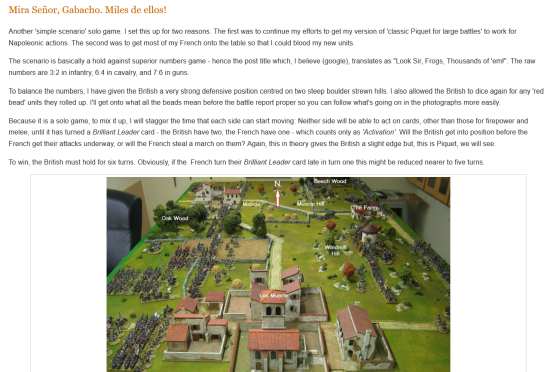
160 pages. Illustrations (mostly color) throughout. Introduction, Notes on Paints Used, and Glossary.
According to the back cover, author Tony Harwood (dampfpanzerwagon ![]() ) sets out in this volume to show gamers how to start with building their own cost-effective Napoleonic-era buildings. In the two-page introduction, he introduces himself as a terrain builder first, figure painter first, and gamer third. In a note about painting, he explains that because he mixes his own colors, he cannot tell readers simply to use specific paint colors.
) sets out in this volume to show gamers how to start with building their own cost-effective Napoleonic-era buildings. In the two-page introduction, he introduces himself as a terrain builder first, figure painter first, and gamer third. In a note about painting, he explains that because he mixes his own colors, he cannot tell readers simply to use specific paint colors.
The majority of the book consists of nine projects:
Section One: Working in Different Scales
- 1.1 - 15mm Russian Windmill
- 1.2 - 28/30mm Two-Storey French House
- 1.3 - 20mm La Belle Alliance
Section Two: Quick and Easy
- 2.1 - 28/30mm French Pigeonnier
- 2.2 - 28/30mm Stone Built Well
- 2.3 - 28/30mm Russian Granary
Section Three: Detailed, Step-by-Step Tutorials
- 3.1 - 28/30mm Die Kleine Bäckerei
- 3.2 - 28/30mm Hungarian Chapel
- 3.3 - 28/30mm Peninsular Diorama
Each tutorial briefly mentions the inspiration or source for the concept and shows a design sketch, then details the construction and painting process. Step-by-step illustrations are provided, sometimes as many as six pictures per page. Lists are given of materials and paint colors used.
The author showcases a variety of techniques: using strip wood, DAS modelling clay, cardboard, green and blue foam, and balsa wood, as well as how to detail a laser-cut MDF kit.
Each tutorial is well presented, and gives an excellent guide to building and painting the sample projects. However, there is some repetition of technique from tutorial to tutorial. It would have been better to explain basic techniques in detail early in the book, then summarize in later tutorials.
In future books, I hope the author will spend more time explaining why as well as how. For example, the first section of the book is where he shows how to build projects in three different scales, yet he never explains how his approach differs to each scale – he simply shows what he's doing, step by step.
While the tutorials are well illustrated, when there are multiple pictures per page, the pictures can be rather small. It can be hard to see what the author has done when the photo is of the entire project; close-ups would have been useful on occasion.
While the author explains the building and painting process, he unfortunately gives little description of how he comes up with his concepts, and how he turns these into actual plans. While the author may give a reference to a book, the starting terrain builder for whom the book is intended will not know how to do this research. Similarly, the author typically shows his design plan, but fails to teach how others can devise plans for themselves. It might have been nice if the designs had been published in a larger size, so that readers could build these projects themselves.
Finally, the author explains that he's not primarily a gamer, which no doubt explains why he seldom describes how these projects would be used on a wargaming table. Certainly the general techniques will be helpful to all gamers, but it would have been better for the author to consider projects which gamers might need for the battlefield.
The author typically does not explain how to use figures with these buildings, and none of the buildings feature access to the interior.
The book is highly recommended for anyone wanting to learn a variety of techniques for low-cost construction of buildings and other scenics.
Reviewed by ![]() Editor in Chief Bill
Editor in Chief Bill ![]()
![]() .
.









